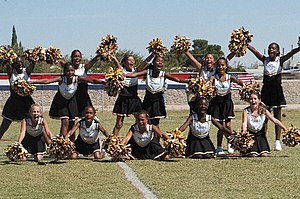Pom-pom

A pom-pon (also spelled pompom) is a fluffy, decorative ball or tuft. Pom-pons may come in many colors, sizes, and varieties and are made from a wide array of materials, including wool, cotton, paper, plastic, and occasionally feathers.
Its most prominent use is its use by cheerleaders and sports fans during spectator sports.
Two related words, toorie and bobble, are most often used when referring to clothing.
Pom-pon is derived from the French word pompon, which refers to a small decorative ball made of fabric or feathers
Spelling
Webster's Third New International Dictionary (1961) gives the spelling as "pompon."
The New Oxford American Dictionary (third edition, 2010) gives the spelling as "pom-pom."
The American Heritage Dictionary of the English Language (5th edition, 2011) gives the spelling as "pompom."
Webster's New World College Dictionary (fourth edition) gives the spelling as "pompom."
Among cheerleaders, the spelling "pom-pon" is most often used.[1][2][3][4][5][6] Most commercial providers of cheerleading equipment also use the "pom-pon" spelling.[7]
Sports

Cheerleaders use pom-pons for four main reasons:
- to attract the attention of the spectators
- to add "sparkle" to a cheer, chant, or dance routine
- to accentuate movements
- to distract the opposing team
Most often, pom-pons are used in pairs (one in each hand), but this may vary with the particular requirements of the choreography of a dance or cheer.
Cheerleading pom-pons come in a variety of shapes, styles, colors, color combinations, and sizes. Shiny metallic pom-pons have become very popular in recent years.

Pom-pons are also waved by sports fans, primarily at college and high school sports events in the United States, Cheap, light-weight faux pom-pons in team colors are sometimes given or sold to spectators at such events.
Many schools and universities have dance teams in addition to their cheerleading groups. The dance teams may also use pom-pons occasionally.
Clothing
Large handheld pom-pons are used by cheerleaders and sports fans. Smaller ones may adorn hats (such as Tam o' Shanters and some styles of the tuque), socks, fringed dresses, or other kinds of clothing.
Pom-pons form a conspicuous part of the uniform of French naval personnel, being sewn onto the crown of their round cap. Belgian sailors wear a light blue version.
Traditional Italian wedding shoes have small pom-pons, as do some Turkish dancing shoes.
Roman Catholic clergymen
Roman Catholic clergymen wear the biretta. The colour of its pom-pon denotes the wearer's rank. Priests wear a black biretta with a black pom. Protonotaries and Domestic Prelates (now Prelates of Honour) have a scarlet pom on their black birettas, and Papal Chamberlains (now Chaplains to His Holiness) wear a Roman purple pom on their black birettas.
Bishops and Archbishops wear a Roman purple biretta with matching pom. The scarlet birettas of the Cardinals have no pom, only a red loop. There is no Papal biretta.
Some religious orders and congregations have unique birettas, such as the Norbertines who wear a white biretta with a white pom. Some St. Francis fathers wear a brown biretta with a black pom. Other orders may wear a black biretta with a white, green, or blue pom, or the black biretta of the secular priesthood.
Toorie

In reference to Scottish Highland dress and Scottish military uniforms, the small pom-pon on the crown of such hats as the Balmoral, the Glengarry, and the Tam o' Shanter is called a "toorie."
The toorie is generally made of yarn and is traditionally red on both Balmorals and Glengarries (although specific units have used other colours). It has evolved into the smaller pom-pon found on older-style golf caps and the button atop baseball caps.
Flogger

In Australia, the term "flogger" is used rather than "pom-pon." Floggers are very large, heavy pom-pons in the team's colours. They sometimes require more than one person to lift them, and they are waved about when a goal is scored.
Floggers are an important part of Australian rules football culture and cheersquads.
Toys and bicycles
Pom-pons are sometimes used as children's toys. They are a common feature at the ends of the handlebars of children's tricycles and bicycles, especially girls' bicycles.
References
- ^ Inside Cheerleading Magazine[clarification needed]
- ^ American Cheerleader Magazine[clarification needed]
- ^ Cheer Coach & Advisor Magazine[clarification needed]
- ^ AACCA[clarification needed]
- ^ USASF[clarification needed]
- ^ NFHS (National Federation for State High School Associations)[clarification needed]
- ^ E.g., Varsity.com[clarification needed]
